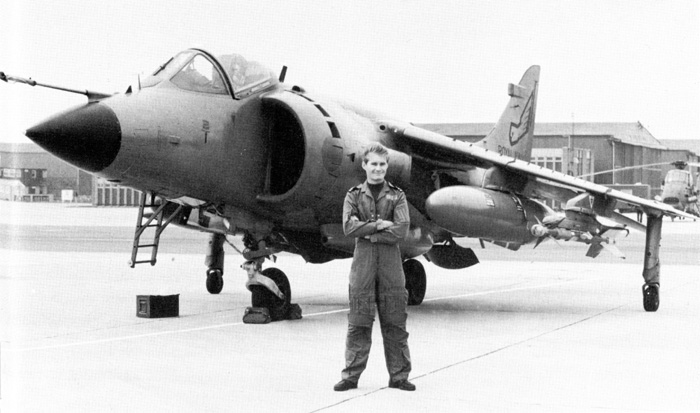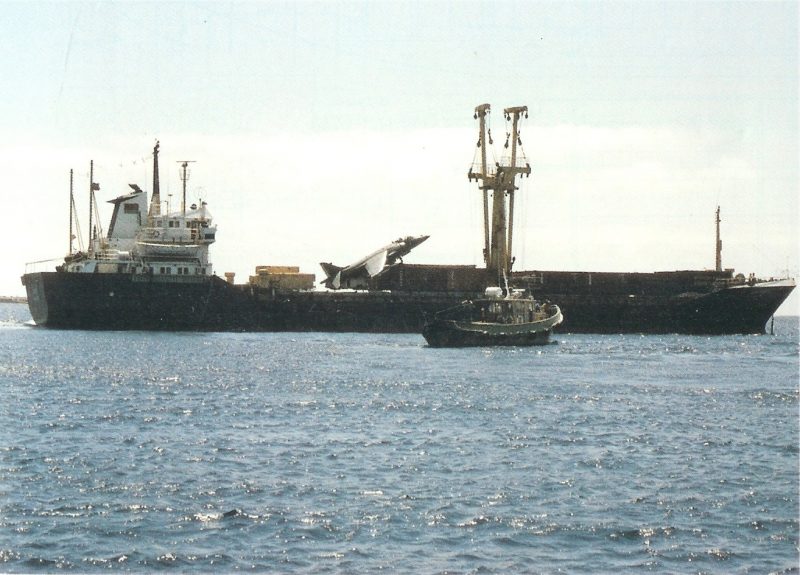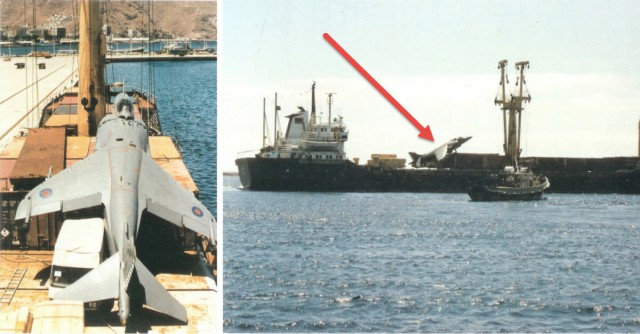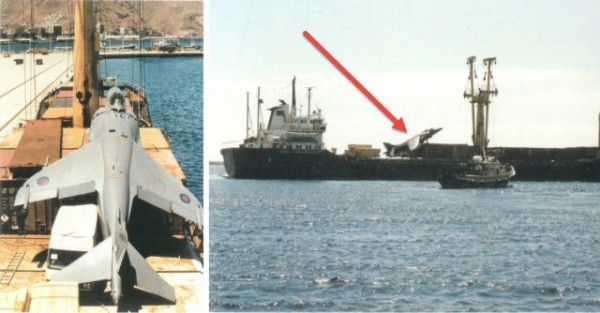The events described here took place 32 years ago. In June 1983, Sub-Lieutenant Ian “Soapy” Watson got inside his Sea Harrier and launched off from the ski-ramp on the HMS Illustrious. Together with him, there was a senior pilot in another aircraft. This training mission was part of a large-scale NATO exercise. The goal of the mission was finding an OPFOR (opposing force) French Clemenceau-class carrier near the coast of Portugal. The two pilots were simulating combat-like conditions. This involved flying with the radar off and radios silent, that way reducing the chances of the enemy being able to detect them. The two pilots split up after reaching the designated area. They climbed to the desired altitude, turned on radars and started scanning their areas for the enemy.

Meanwhile, another unsuspecting vessel was in the area while the exercise was developing. The Spanish, civilian, container ship called Alraigo was on its way to Tenerife, the Canary Islands.
After Watson completed the search he lowered altitude and headed to the point where he was supposed to join up with his leader. Something was suspicious. The leader of the flight didn’t show up there. Looking at the fuel reserves that were pretty low, Watson decided that is time to get back to his ship. He tried using his navigation instruments to help him find the ship. He used the inertial navigation system (INS) but didn’t manage to get any results from it. The radar was working, but nothing showed up on the screen. He tried the radios and realized they weren’t working at all. He tried hitting the emergency button on the transponder, but that didn’t work either. Watson was completely cut off from the mission command. The young pilot was flying around, wasting his precious fuel. He needed to think fast.
Watson remembered that the shipping lanes are close to the coast and headed East. His radar immediately showed a target. It was the Alraigo! Soapy turned his plane towards the ship. He was down to the bottom of his fuel tank, one minute of flight time precisely. His initial plan was to make a flyby over the ship, to get their attention, and then eject. During the flyby, he noticed that the top containers on the ship formed something that looked like a deck, similar to the ones carriers have. without much hesitation, Watson got closer and landed down on the containers. he slowed his aircraft down and made it hover over the containers.
This wasn’t the end of the landing. The Harrier began to slide backward. The aircraft was sliding because the containers were wet and the ship was still in motion. The plane’s engines didn’t manage to stop it from sliding down. Watson tried to pull up the landing gear, but that didn’t help either. Finally, the Harrier stopped, it landed on the roof of what seemed to be a delivery van tied down on the deck of Alraigo.
The story continues: The ship’s captain had his own plans for the plane and the pilot. While his crew was helping Soapy get out of the cockpit, he called the authorities and notified them about the incident. He was asked to turn around and return the extra passenger, but refused, after all, he had containers to deliver and a schedule to follow! The captain of the Alraigo informed the British government that Watson and his plane will be in Tenerife in four days when the ship arrives.
When the Alraigo arrived in Tenerife, it was welcomed with a huge crowd of locals and reporters. It is not every day that they get this kind of delivery on the island.

The ship owners didn’t let their service go unrewarded. They filed a salvage claim for the aircraft and it was a pretty good deal. The crew and the owners were given £570,000 (worth $1.14 million back in 1983), as a gratitude for their “rescue” efforts.
Sub-Lieutenant Ian “Soapy” Watson, our main protagonist was lucky to be alive. He was returned to the HMS Illustrious. There was a Board of Inquiry held onboard and ended without any repercussions for Warson. But when the Ship returned to port, Watson was sent on a secondary Board of Inquiry.
Several years ago, in 2007, Britain’s National Archives made the report from the second inquiry free for public view. In the report, it was written that the cause for the accident was Watson’s inexperience, and his commanders were blamed for assigning him an airplane “not fully prepared for the sortie,” probably referring to the radio issues. Watson wasn’t too terribly charged for his actions. He was reprimanded and given a desk job. Eventually, he ended up flying again. He managed to acquire 2 000 flight hours in Sea Harriers and additional 900 hours flying in F/A-18s. He resigned from the navy in 1996.
When asked about the events Watson says that the media caused a lot of damage and embarrassment to the British Royal Navy. He doesn’t want to blame anybody for what happened.
Here is an actual news video from the time when the incident happened:
Source: airspacemag, tacairnet,

